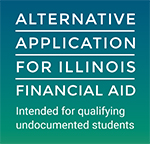Financial Aid: Completing the FAFSA®
Special Notice regarding the federal process for requesting financial aid
2024-25 FAFSA now available
As part of implementation of the FAFSA Simplification Act, the 2024-25 federal process for requesting financial assistance reflects the changes outlined below.
- Up to 20 different colleges can be listed on the online FAFSA (up to ten colleges can be listed if the paper FAFSA is completed) and have information sent to them (in prior years, only ten colleges could be listed on the online FAFSA, with a maximum of four colleges on the paper FAFSA).
- Due to a change in the methodology used to determine aid, a Student Aid Index (SAI) – rather than an expected family contribution (EFC) – is used to measure your (and, if applicable, your family's) ability to pay for college.
- The new need analysis formula no longer factors the number of family members attending college into the calculation.
- Separate criteria to determine eligibility for the Federal Pell Grant Program, linking eligibility to family size and the federal poverty level, make program funds available to more students.
- Revisions to several of the processes and systems used to award federal student aid are required, including a new interface to directly receive federal tax information from the Internal Revenue Service (IRS) – this change is made possible by the Fostering Undergraduate Talent by Unlocking Resources for Education Act (FUTURE Act).
You may also wish to visit the Federal Student Aid studentaid.gov website for more information.
2023-24 applications remain available
While the information on this page refers primarily to the federal process for requesting financial assistance for the 2024-25 academic year, the FAFSA and Alternative Application for the 2023-24 academic year remain available for students to complete and submit.
The first step in the financial aid process is to complete a Free Application for Federal Student Aid (FAFSA®). This application, which is available to complete online via desktop and laptop computers, mobile devices*, or in paper/PDF format, uses income, assets and other factors to determine the amount you and your family are expected to contribute to your college expenses. Most of the questions are demographic-related and the rest of the answers come from your tax forms and/or those of your parents (if you’re a dependent student) or your spouse (if you are married). If you file the FAFSA online, you can list as many as 20 different colleges that you may be attending and have information sent to them (only ten colleges can be listed on the paper/PDF version of the FAFSA). Your eligibility for financial aid will be determined by your and your family’s financial situation, and by filing your application on time.

If you are an Illinois student who is not eligible for federal financial aid (and do not file the FAFSA), you may apply for a State of Illinois Monetary Award Program (MAP) grant using the online Alternative Application for Illinois Financial Aid, which is patterned after the FAFSA. For more information, visit the Retention of Illinois Students & Equity (RISE) Act page of this website, and talk with your high school counselor or the financial aid office at your college or university.
For specific instructions on how to complete the FAFSA, visit the Filling Out the FAFSA page of Federal Student Aid’s StudentAid.gov.
* StudentAid.gov is mobile-responsive and the FAFSA may be completed using a mobile device.
How and When to File the FAFSA
Complete your FAFSA as soon as it becomes available each year. The 2024-25 FAFSA is now available. You can complete the FAFSA online or by using a paper/PDF application.
2022 income information is used with the 2024-25 FAFSA. For the quickest results, apply online. Review the Filling Out the FAFSA Form page at Federal Student Aid's StudentAid.gov for more information.
In order to submit your application online, you must obtain an FSA ID from the U.S. Department of Education. Beginning with the 2024-25 academic year, all people providing information on the FAFSA – even those without a Social Security number (SSN) – must create an FSA ID. FSA ID request records with an SSN are sent to the Social Security Administration to be matched. Records without an SSN will be sent through a new matching process.
The student (applicant) and all contributors (which may include a Student Spouse, Parent, and/or Parent Spouse or Partner) must provide consent for tax information to be provided directly from the Internal Revenue Service (IRS) – even if the contributor didn't file a tax return. If the student or another contributor does not provide consent and approval, the student will not be eligible for federal student aid.
In most cases, no further documentation is needed to verify the income information being transferred into the FAFSA directly from the IRS. However, if income tax return information is not available or cannot be used, the student may be asked to provide the institution with an IRS Tax Return Transcript(s) or a signed copy of the income tax return and applicable schedules for the appropriate tax year (tax year 2022 for the 2024-25 FAFSA).
- Online – with the proper identity verification, tax transcripts may be viewed and downloaded from the IRS Get Transcript Online resource;
- By Mail – requests to have tax transcripts sent via the mail may be submitted to the IRS using their Get Transcript by Mail tool;
- By Phone – the taxpayer can call 1.800.908.9946, and a transcript will be delivered to the address of record within ten business days; and,
- By Paper Request – the taxpayer can use IRS Form 4506T-EZ or IRS Form 4506-T (accessed via the IRS Forms, Instructions and Publications page) to request tax transcripts, and a transcript will be delivered to the address of record within ten business days from the IRS’s receipt of the paper request form.
If you are unable to complete the FAFSA online, but do have Internet access, you may download a PDF version of the FAFSA via the Filling Out the FAFSA Form page at Federal Student Aid's StudentAid.gov. You may complete the PDF version of the FAFSA on the computer (fillable form) or by hand, then mail it to the address provided on the document. You may also request a paper FAFSA by calling the Federal Student Aid Information Center (FSAIC) toll-free at 800.4FEDAID (800.433.3243).
If you or your parents need help completing your FAFSA, be wary of hiring a consultant. It may not be wise to pay for a service that’s free of charge elsewhere, and sometimes these services are simply scams. Each year, colleges and other community sites hosts College Awareness & Preparation events, which are free to the public. Most events feature FAFSA Workshops with financial aid professionals available to answer any financial aid questions and help you complete your FAFSA—at no charge. Be sure to bring your tax forms, and your parents’ tax forms if you’re a dependent student, to any workshop you attend.
After Filing the FAFSA
Once processed by the U.S. Department of Education, you will receive a summary of your FAFSA results, called a FAFSA Submission Summary. The colleges you listed on your FAFSA will also receive the results, in order to determine your financial aid eligibility and prepare a financial aid package for you. The information reported on the FAFSA is confidential and remains within the financial aid office; it is not shared campus-wide. You may be asked to submit documentation to the financial aid office at the college to verify the information reported on the FAFSA.

 ISAC Student Portal
ISAC Student Portal


